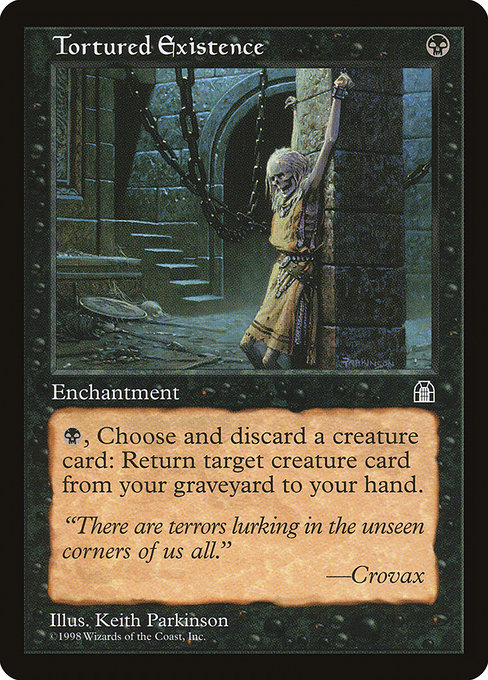
Image courtesy of Scryfall.com
Tracing the Evolving Lore Behind Tortured Existence
Black magic in MTG has always thrived on the edge of life and death, and Tortured Existence is a compact whisper of that philosophy. For a single black mana, you pay B and discard a creature card to return a creature card from your graveyard to your hand. It’s a tempo-play with a twist: you burn a little resource to harvest a future threat, all while stoking the fires of your graveyard. The card’s art, painted by Keith Parkinson, drenches the frame in shadowy dread, hinting at the ritualistic hush that follows a decision to claw something back from oblivion 🧙♂️🔥. The flavor text seals the mood: “There are terrors lurking in the unseen corners of us all.” —Crovax, a nod to the long, murky thread connecting vampiric ambition, necromancy, and the moral gray zones that fans love to dissect 🎨💎.
From Stronghold’s Shadows to the Graveyard’s Grimoire
Released with Stronghold in 1998, Tortured Existence sits squarely in a period when MTG was leaning hard into the graveyard as a context-rich resource. Its ability showcases a core black mechanic: discard to gain a future advantage. This is not reanimation to the battlefield; it’s a deliberate swing of the pendulum—pull a creature out of the graveyard back into your hand, ready to be recast on the next turn. That small, precise exchange embodies a larger lore thread in Dominaria’s dark corners: the dead are not truly gone; they’re waiting, listening, and sometimes bargaining for a second life. The card’s rarity—common—belies its enduring influence, which is exactly the kind of design that kept players peering into the shadows between draws 🧙♂️⚔️.
Story Threads: Vampires, Necromancy, and the Hand of Fate
The flavor text anchors Tortured Existence to the vampire lore that threads through MTG’s history, with Crovax as a touchstone. Crovax’s presence in the card’s lore signals a broader narrative where mortality, hunger, and the thirst for power collide in a world where the dead are a resource—sometimes a temptation, sometimes a weapon. Although Tortured Existence itself is a small, practical enchantment, its story taps into a larger conversation about the undead and the consequences of reaching into the grave for strength. This is a microcosm of the way MTG has evolved: a card that began as a single strategic tool wove itself into a tapestry of characters, factions, and ancient grievances that fans chase across decades 🧙♂️🔥.
Gameplay as Lore: How the Card Tells a Story On-Table
Mechanically, Tortured Existence invites you to balance sacrifice and retrieval. Discarding a creature card to recover a creature from the graveyard creates a mini-puzzle: what creature do you want back, and how do you best leverage your graveyard as a staging area? The card’s cadence—play, discard, retrieve—echoes the cadence of necromantic plots in many MTG storylines: a whisper of a plan, followed by a necessary cost, and then the moment when a revenant steps back into the fray. In Commander and Legacy, where graveyard-centric strategies have become a staple, Tortured Existence shines as a budget-friendly engine that can enable recurring threats, tempo control, or a re-use of key bodies in the late game 🧙♂️🎲. Its black identity is clear: use what’s fallen to fuel what might yet stand again, and do it with a grin as dark as the card’s art.
Evolution of the Graveyard Narratives in MTG Across Eras
Across sets and years, MTG has expanded the graveyard from a mere discard pile into a central battlefield of possibilities. Tortured Existence foreshadowed the era when returning a card to hand (or battlefield) became a recurrent theme—think Eternal Witness’s lifeline, or Nethertangle-style loops that reward careful sequencing. This evolution mirrors black’s long-running fascination with cost-and-reward cycles: sacrifice something valuable now to ensure you have the tool you need later. The card’s presence in Stronghold’s era—an era renowned for its moody, artful darkness—helps explain why later designers leaned into graveyard-centric engines and reanimation archetypes. The ongoing dialogue between “hand” and “graveyard” remains a core pillar of black’s identity, and Tortured Existence stands as one of the early, elegant chords in that melody 🧙♂️💎.
Collecting, Art, and Cultural Resonance
As a common card from the late 1990s, Tortured Existence doesn’t dominate price lists the way mythic rares do, but its place in the history of black recursion makes it a cherished collectible for many players who love the lore. The card’s artwork by Keith Parkinson remains emblematic of the Stronghold era’s moody fantasy, and the text—shielded behind a simple, potent line—remains a favorite for judges and flavor fans alike. Market values float with condition and printing, with non-foil printings commonly found and a steady presence in commander circles where graveyard synergy runs deep. Its EDHREC rank sits at 1613, a reminder that while it’s not a top-tier staple, it threads through countless decks as a reliable piece of a deeper puzzle. For players who treasure the lore of vampires and necromancy, Tortured Existence is a bite-sized tale you can replay and savor with every draw ⚔️🎨.
Speaking of durability and reliability, you’ve got to keep your gear as battle-ready as your board. If you’re hitting tournaments or weekend events, a rugged, protective case for your devices can be a quiet but crucial ally—much like Tortured Existence quietly fueling a late-game plan. For a sturdy option that travels as well as it protects, consider the rugged case linked below — a practical companion to any card-crazed adventure. Rugged Phone Case
More from our network
- https://blog.rusty-articles.xyz/blog/post/whirlipede-win-rate-revealed-in-top-tournament-decks/
- https://blog.rusty-articles.xyz/blog/post/how-mabosstiff-stacks-up-against-similar-pokemon-in-tcg/
- https://crypto-acolytes.xyz/blog/post/hidden-ps2-gems-never-released-in-north-america/
- https://transparent-paper.shop/blog/blog/designing-creative-proposal-templates-that-win-clients/
- https://blog.digital-vault.xyz/blog/post/from-concept-to-completion-building-a-digital-product/